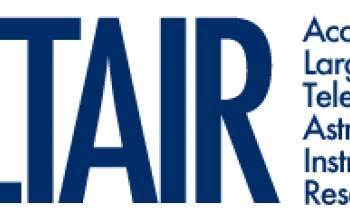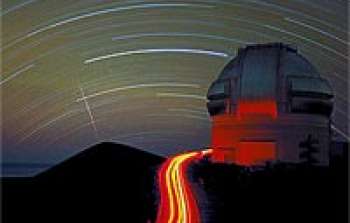sci08015 — Announcement
ALTAIR Survey Results
September 30, 2008
In a previous issue of Currents, readers were encouraged to respond to the online survey of the ALTAIR committee. The ALTAIR committee is charged with understanding the needs of the US community for observing resources (such as instrumentation, observing modes, and observing time) on large aperture (6.5- to 10-m) telescopes both now and in the 2010-2020 decade.
We received over 500 survey responses during the two-month survey period (2008 July 15-August 15). The large number of responses attests to the existence of a significant, energized community of large telescope users. Some strong common themes emerged and are highlighted here. The reported results are from the first month of the survey (representing approximately 500 responses); these early results have been analyzed more completely. For those interested in relating the results described here to the survey questions and format, please note that the original survey form can still be accessed at the survey Web site.
Survey Topics: The survey focused on three general topics. It first asked respondents for demographic information about themselves (e.g., their science research areas, the type of institution with which they are associated, the nature of their current position at that institution, and whether they have institutional access to large telescopes). The survey then explored the needs of respondents for resources associated with large aperture telescopes (observing time, instruments, observing modes, data reduction pipelines, and archives). Finally, respondents were offered the opportunity to comment in a more open-ended way on issues such as their experiences using Gemini and other large aperture telescopes, their anticipated future science, and their priorities for any potential increases in federal funding for large aperture telescopes.
Demographics: The survey respondents represent a wide range of science research areas, from cosmology to solar system studies. They are students, post-docs, faculty and staff, and administrators. Responses were received from over 100 institutions, including colleges, universities, government laboratories, federally funded astronomy centers, and the NSF. Approximately half of the respondents have access via their institution to one or more large telescopes. More than 80% of the respondents have experience using a large aperture telescope, and about 60% have proposed to use the Gemini telescopes as a PI or co-I.
Observing Time: Respondents indicated that it is critical to increase the observing time available to the US community on large aperture telescopes. The discrepancy between the number of nights for which an individual respondent has proposed versus the number of nights received is particularly large for respondents without institutional access to large telescopes. Increasing the observing time available on large telescopes is also related to the strong sentiment expressed in the survey that it is critical for students and post-docs to have experience observing with large telescopes and/or the data from these facilities.
Observing Modes: The survey revealed that both queue and classical scheduling are popular and valued observing modes. However, in a resource-limited environment, queue scheduling is viewed to be less critical than improvements to instrumentation or to an increased number of nights for observing. This view was held by respondents both with and without institutional access to large telescopes. One reason for the popularity of queue scheduling, despite its non-critical nature for many respondents, is that it offers convenience. Convenience was the second most frequently cited reason for valuing queue scheduling.
Gemini Observatory: One of the most striking results of the survey was the response to the essay-format question that asked, “If you have used both Gemini and non-federal facilities, how does Gemini compare with these facilities?” Many respondents commented thoughtfully and passionately in response to this question. Overall, the responses revealed broad dissatisfaction with Gemini, with Gemini characterized as uncompetitive or lagging relative to other large telescope facilities. Respondents remained fundamentally supportive of Gemini, but they found their experiences with Gemini frustrating and were disappointed that Gemini does not perform better.
Respondents commented favorably on the good seeing of Gemini as well as its infrared performance, queue scheduling, and the ability to accommodate targets of opportunity. However, there was also strong criticism that Gemini instrumentation is uncompetitive with instrumentation available on other large telescopes and is not well aligned with the needs of a broad community of users. The second most common concern, which also elicited passion, was the large amount of time that a proposer must spend at all stages of the process to end up with science quality data. Respondents commented on the time burden of the Phase II process, concerns about data quality and observing efficiency, and the possibility of receiving little useful or no data for all the effort expended. Others expressed a strong desire to be more actively involved in collecting their own data through classical observing or a remote eavesdropping process.
Priorities for Federal Funding Increases: Another informative result was the response to the question, “If increased federal funding for large telescopes would enable a significant enhancement to your research, what level and kind of investment would you advocate?” Respondents were invited to indicate their funding priorities. A list of possible choices included: (1) increasing the US share in the Gemini telescopes; (2) increasing the open access time available on non-federal facilities; (3) increasing funding for instrumentation on Gemini or (4) on non-federal facilities; building a new 8-m class telescope, either (5) a generic facility or (6) one targeted toward a special purpose. Respondents could also select “None of the above” or “Other.”
The highest priority was for more open access time on non-federal facilities, for both groups with and without institutional access to large telescopes. The second priority, both overall and for the group without institutional access, was for increasing the US share in Gemini. For the group with institutional access, the second priority was for increased funding for instrumentation on non-federal facilities.
Thus, the results of the ALTAIR survey complement the results from an earlier Currents survey in which we asked readers whether they were in favor of an increased number of nights on Gemini and/or an increased US share in Gemini. The approximately 60 respondents to the Currents survey were greatly in favor of both options, by a margin of 5 to 1. The ALTAIR survey indicates that an increased investment in Gemini is a lower priority when compared with the option of increased observing time on non-federal facilities. Several respondents commented that increasing the US investment in Gemini would be a higher priority for them if Gemini were more responsive to the needs of the US community.
International Context: Another important theme from the survey is the sentiment that improvements to instrumentation and increased observing time are critical for the US to remain competitive with other countries.
Next Steps: The results of the survey are one element of the input that the ALTAIR committee will consider in their deliberations. The survey results are valuable in that they provide a snapshot of the broad community perspective on large telescope resources. In the next few months, the committee will complete its analysis of the entire survey sample. The results will assist the committee in meeting its charge to help formulate the US position on Gemini (with particular attention to the transition in 2012 to a new international agreement) and to provide recommendations that guide federal activities aimed at expanding the system of large telescopes using TSIP or other mechanisms.
Developments in this process will be reported in future issues of Currents. In the meantime, if you have any comments on the results of the ALTAIR survey, please write to currents@noao.edu. Responses will be forwarded to the ALTAIR committee. We look forward to hearing from you!
Contacts
ALTAIR committee.
About the Announcement
| Id: |
ID
sci08015
|


